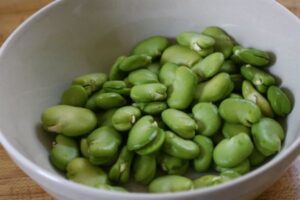The Secrets to Fava Beans (Liver and Nice Chianti Optional)

You may be wary of fava beans, particularly if you saw The Silence of the Lambs, but also because of their price. In the States, most food that isn’t local has to be priced by volume because of the cost of transportation, so fava beans may cost you a pretty penny, especially considering how little food you get inside the giant pods. However, there’s a reason everyone’s talking about fava beans, and you can enjoy them at home with a bit of time and effort. Just a bit.
What Are They?
Fava beans are one of the oldest cultivated plants; these beans, related to common garden peas, were eaten in ancient Rome. The Italians have continued making them ever since, and they remain popular in Mediterranean cuisine. They are just coming into season now, and they’re perfect with other spring vegetables like artichokes and garden peas. Their flavor is buttery and nutty, and it goes perfectly with Italian extra-virgin olive oil.
How Can I Get Some?
While fava beans have recently become widely available in American markets, many don’t want to shell (pun intended) out the dough for a lot of weight and very little edible volume. However, contrary to what you might assume from their high price, fava beans are actually extremely easy to grow. Try planting fava beans in your garden, either with sprouted plants or seeds, and let them climb. Not only are the stalks beautiful, but soon you’ll have more fava beans than you know what to do with! Which brings us to the next question…
What Do I Do With Them?
Preparing fava beans to be eaten can be a labor-intensive process. Imagine giant Italian families, sitting around the garden and chatting as they string and shuck fava beans. It can take an afternoon to get a good amount for a lot of people, but it can be a fun weekend activity with your friends and family. Each bean has to have its string and woody shell removed, before being parboiled and shelled again to remove their waxy skins. This can be more easily achieved by dumping the just-parboiled beans into a bowl of ice water, and then rubbing them between your fingers to remove the skins.
Once the beans have been fully shelled, the sky’s the limit. Here are some of our favorite recipes here at Organic Authority, but feel free to play around on your own!
- Risotto with Artichokes and Fava Beans, a springtime double-header from the New York Times
- Arugula and Fava Bean Bruschetta
- Slow Roasted Copper River Salmon served with Fresh Organic Fava Bean Sauce
- Fava Beans with Garlic, from the Mayo Clinic
- Grilled Fava Beans, a different way to enjoy this springtime treat from 101 Cookbooks
- Bobby Flay’s Fava Bean Salad with Lemon Vinaigrette and Shaved Manchego Cheese
Image: Jen SFO-BCN










